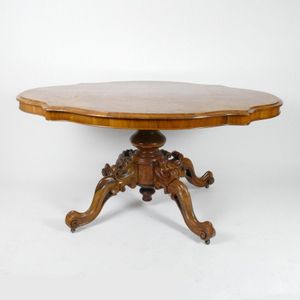Victorian Walnut Tilt-Top Supper Table with Casters
You must be a subscriber, and be logged in to view price and dealer details.
Subscribe Now to view actual auction price for this item
When you subscribe, you have the option of setting the currency in which to display prices to $Au, $US, $NZ or Stg.
- Reeding - A series of parallel, raised convex mouldings or bands, in section resembling a series of the letter 'm'. The opposite form of fluting, with which it is sometimes combined. Reeding is commonly found on chair legs, either turned or straight, on the arms and backs of chairs and couches and around table edges in the Neoclassical or Classical Revival manner. Reeding was also used as a form of decoration during the Edwardian period, but it is usually much shallower and evidently machine made.
- Victorian Period - The Victorian period of furniture and decorative arts design covers the reign of Queen Victoria from 1837 to 1901. There was not one dominant style of furniture in the Victorian period. Designers used and modified many historical styles such as Gothic, Tudor, Elizabethan, English Rococo, Neoclassical and others, although use of some styles, such as English Rococo and Gothic tended to dominate the furniture manufacture of the period.
The Victorian period was preceded by the Regency and William IV periods, and followed by the Edwardian period, named for Edward VII (1841 ? 1910) who was King of the United Kingdom and the British Dominions and Emperor of India for the brief period from 1901 until his death in 1910. - Turning - Any part of a piece of furniture that has been turned and shaped with chisels on a lathe. Turned sections include legs, columns, feet, finials, pedestals, stretchers, spindles etc. There have been many varieties and fashions over the centuries: baluster, melon, barley-sugar, bobbin, cotton-reel, rope-twist, and so on. Split turning implies a turned section that has been cut in half lengthwise and applied to a cabinet front as a false decorative support.
This item has been included into following indexes:
Visually similar items

Georgian oak centre table, c. 1760, circular top above a tripod base terminating in hoof feet, height 70 cm, diameter 83 cm. Provenance: The Collection of Lady Sybil Joel, Sydney

A Victorian walnut serpentine loo table, the top with book-matched oyster shell veneer, raised on a heavy baluster column from four ornately carved legs. 148 cm x 106 cm x 72 cm

A 19th century mahogany circular centre table, the top with thumb moulded edge, raised on a baluster column from a carved tripod base with brass casters. Diameter 121 cm x 73.5 cm

A Victorian oval walnut veneered tea table. 71 cm high, 106 cm wide, 60 cm deep
